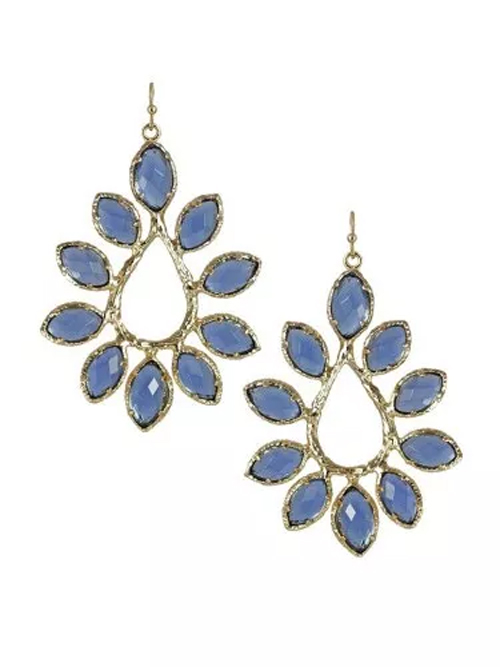The name and origin of cordierite
The English name of cordierite is Cordierite, to commemorate the French geologist P. L. A. Named after Coedier, the gem-grade cordierite, English name is Iolite or Dichroite. Iolite is derived from the Greek word for "violet" and symbolizes the color characteristics of gem-quality cordierite. Cordierite has obvious pleochroism, and it can be seen from the different angles with the naked eye, and its color can be obviously changed.

What is cordierite?
The chemical composition is a silicate rich in iron, magnesium and aluminum. The magnesium in the composition can be replaced by iron or manganese, and part of the aluminum can also be replaced by iron. The crystals are mostly short-column, and occasionally contain inclusions such as sillimanite, spinel, zircon, apatite, and mica in the crystal. The color is generally light blue, dark blue or grayish blue, some are colorless, white, gray, light yellow, light purple or light brown, while weathered, it is slightly green. If the degree of weathering increases, cordierite can be changed to mica, chlorite or talc.
Type of cordierite
1. Iron phthalocyanine: The two main components of cordierite, magnesium and iron, can be used as the same image. When the iron content is greater than the magnesium element, it is called iron ruthenium.
2, cordierite: that is, the magnesium content is higher than the iron content called cordierite, more famous is the magnesium-rich variety produced in India, often used to make gems, also known as Indian stone.
3, blood point cordierite: the main producing area in Sri Lanka, the main feature is that the internal iron oxide bath tablets are rich in content and arranged in a specific direction so that cordierite with a ribbon is called blood point cordierite.
Brooch: A brooch composed of chalcedony, olivine, topaz, cordierite (purple): composed of chalcedony, olivine, topaz, cordierite (purple).

The difference between cordierite and sapphire
1, the hardness is different: sapphire is corundum, hardness reaches 9; cordierite hardness is only 7 ~ 7.5.
2, the density is different: cordierite density is significantly smaller than sapphire, handcuffs no weight.
3, the color is different: Although the main color of both is blue, but the pleochroism of cordierite is very obvious, you can see different colors from different angles; sapphire does not.
4, the gloss is different: the luster of cordierite is weaker than the sapphire.
5, the proportion is different: other conditions are the same, sapphire is heavier than cordierite.
6, the inclusions are different: the interior of cordierite is generally relatively clean, except that sometimes the dust-like mica is wrapped outside the body, and there is no straight or 60-degree, 120-degree angle of ribbon and silk-like inclusions.
7, the price is different: a string of ordinary cordierite bracelets, a few hundred dollars can be bought. The quality of the good face, nothing more than a few thousand dollars. Sapphire is the leader in the gem world, and their prices are not the same.
Home textiles refer to the various types of fabrics and materials used in the home for functional and decorative purposes. These include bedding, curtains, towels, carpets, rugs, tablecloths, and other decorative fabrics used for upholstery, cushions, and wall hangings.
Bedding: Home textiles include various types of bedding such as sheets, pillowcases, comforters, duvets, bedspreads, and bed skirts. These are available in a wide range of materials such as cotton, silk, linen, and synthetic fabrics.
Curtains: Curtains are used for privacy, light control, and decoration. They are available in a variety of styles, colors, and materials such as cotton, silk, linen, and synthetic fabrics.
Towels: Towels are used for drying after a shower or bath, and for wiping hands and faces. They are available in a variety of sizes, colors, and materials such as cotton, microfiber, and bamboo.
Carpets and rugs: Carpets and rugs are used for adding warmth and comfort to a room, as well as for decoration. They are available in a variety of materials such as wool, silk, cotton, and synthetic fibers.
Tablecloths: Tablecloths are used for protecting the table from spills and scratches, as well as for decoration. They are available in a variety of materials such as cotton, linen, and synthetic fabrics.
Upholstery and cushions: Home textiles also include fabrics used for upholstery and cushions. These are available in a variety of materials such as cotton, silk, linen, and synthetic fabrics, and are used for adding comfort and decoration to furniture.
Wall hangings: Wall hangings such as tapestries, quilts, and other decorative fabrics are also considered home textiles. These are used for adding color and texture to walls, and for adding warmth and decoration to a room.
Home Textile,Standard Textile Home,Home Furnishing Textiles,Home Decor Fabric Textiles
changshu tokoh-tex trade co.,ltd , https://www.tokohtex.com